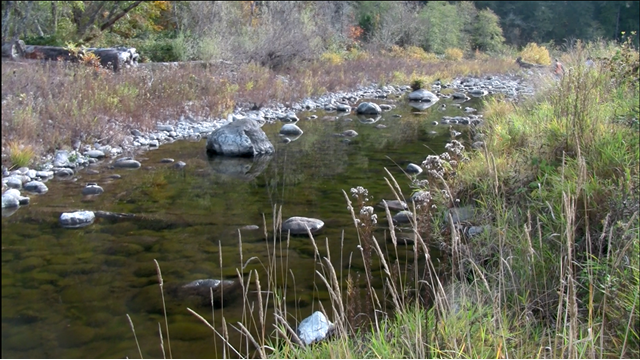Three C Rock Salmon Habitat Project
The Three C Rock campground of Umpqua National Forest is adjacent to some of the most critically important and rare aquatic habitat on the South Umpqua river for salmon refugia. Conditions in the river and its important side channel habitat are used by Coho and Chinook salmon along with sea run Steelhead trout. All of these species area in dire need of assistance if they are going to persist in the upper reaches of the river. Coho salmon are listed as threatened under the Endangered Species Act. SURCP worked with the US Forest Service, the US Fish and Wildlife Service and the Tiller, Oregon school to address habitat problems at the site.

So what are the problems being faced for the habitat? Basically the area suffers from several common problems. First there is very little shade to cool the side channel waters from direct summer sun. Secondly the area is plagued by three aggressive native species. They are Reed Canary Grass, Armenian Blackberries and Bull Frogs. There are lesser issues with noxious weeds like Asian Knap Weed and Scotch Broom.
The real challenge is the Bull Frog population. They devour young native fish and even some land animals of considerable size like juvenile geese, snakes of various types and young Pond Turtles (also a species of concern). The following will illustrate the process of developing and implementing the project.
As part of the Tiller Elementary School Salmon Initiative we guided 6th and 7th grade students through the stages of achieving successful results from a restoration project. After many classes studying the life history of salmon and other aquatic species we began to focus on the challenges these species face to avoid extinction. A review was made of the importance of the riverine conditions at the 3 C Rock reach of the river system. Then a strategy was developed to restore what we could. We then helped the students put together a power point presentation soliciting funding to get the work done. Goals and objectives were established with a budget to fund the work.
Tiller Elementary School Power Point Presentation
Gallery of the Implementation
Plant ID and Plots
Forest Service staff instruct students on the characteristics of native and invasive species. Prior to actual preparation of the landscape for planting plots are laid out and species associated with the plots are noted.
Taking the Invasives Down
Whenever possible SURCP seeks to utilize local businesses and skill sets for the work needing to be accomplished. Here locals applied innovative alterations to their equipment to facilitate removal of invasive plant species from the roots and crowns.
Planting Native Species
US Forest Service staff and SURCP’s Vice President, Chris Rusch, (she is also the Douglas County Oregon’s Master Gardener) carefully select the placement of trees, shrubs and forbes at the site. The rest of the crew begin planting and mulching in earnest.
Purging the Invasive Bull Frog
Bull Frogs are an aggressive non-native species the does serious damage to indigenous species. They were introduced as a commercial venture that failed. The Tiller Elementary school students spent several years attempting to reduce the population and were successful up until the school was closed down. The gallery below depicts a successful early autumn venture into the critically important riverine juvenile salmon refuge.


Catching Bull Frog Tadpoles To Reduce the Population
The Three C Rock project was very successful as long as it lasted. The restoration work was terminated immediately after the Tiller Elementary School was closed down by the local school jurisdiction for fiscal issues.
Monitoring, noxious weed control and invasive predator species were managed until the shutdown.



























































